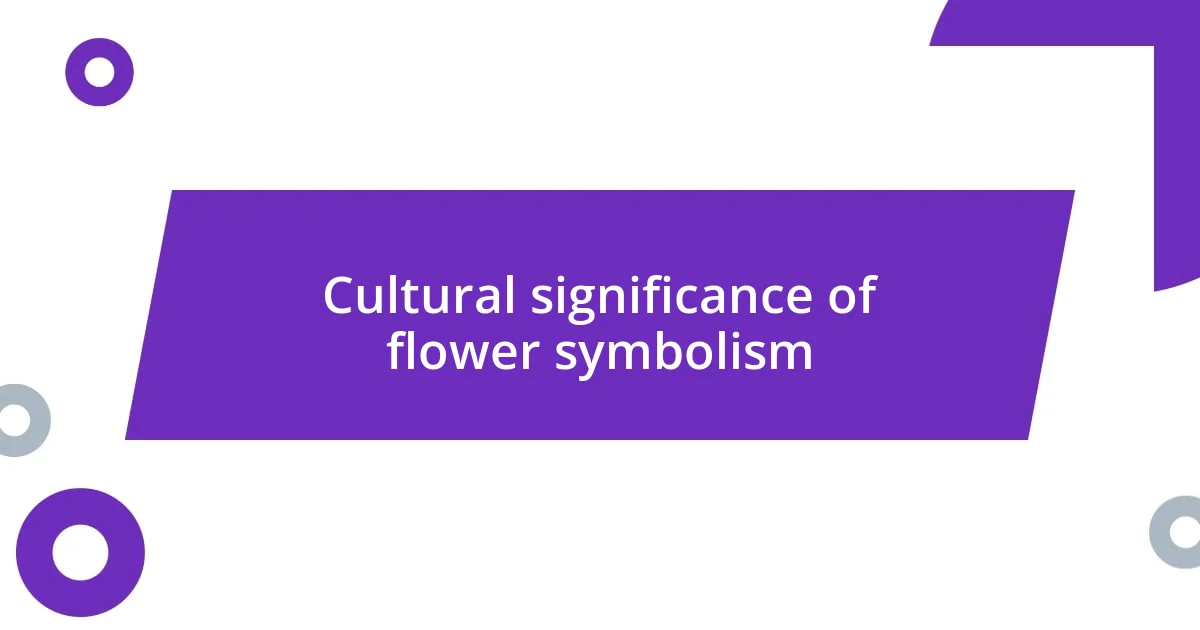Key takeaways:
- Flower symbolism enhances emotional connections and communication, reflecting deeper meanings in personal relationships and cultural rituals.
- Common flowers carry specific meanings, such as roses for love and daisies for innocence, influencing the emotional atmosphere in gifting and decor.
- In literature, flowers serve as potent symbols that evoke complex emotions, illustrating how they can mirror personal experiences and enrich narratives.

Understanding flower symbolism importance
Understanding the importance of flower symbolism can significantly enhance our connections to the natural world. I recall receiving a bouquet of sunflowers during a challenging time; their bright, cheerful demeanor lifted my spirits instantly. It made me ponder—what if we all took the time to understand the deeper meanings behind these natural gifts?
Flower symbolism acts as a bridge between emotion and expression, allowing us to communicate feelings that words sometimes fail to capture. For instance, when I chose to give my friend a lavender plant after her stressful week, it wasn’t just for aesthetics. Lavender symbolizes calmness and serenity—it was my way of hoping to instill some peace in her life. Have you ever sent or received a flower that seemed to resonate with a deeper message?
The layers of meaning held within flowers can guide us in personal relationships and cultural rituals. I remember attending a wedding where the lily was prominent in the decor, known for representing purity and commitment. It made me reflect on how these symbols can evoke shared sentiments among friends and family. Isn’t it fascinating how something so simple can carry such profound significance?

Common flowers and their meanings
When I think of roses, I can’t help but recall the bouquet my partner gave me on our anniversary. Each color holds its own significance, with red representing passionate love, while yellow symbolizes friendship and joy. It’s incredible how a single flower can convey such a spectrum of feelings.
Here’s a quick list of some common flowers and their meanings:
- Roses: Love and romance (red), friendship (yellow), and purity (white).
- Tulips: Perfect love, warmth, and spring renewal.
- Lilies: Purity, devotion, and beauty; often used in weddings.
- Daisies: Innocence, loyalty, and new beginnings.
- Sunflowers: Adoration, loyalty, and happiness; they always remind me of summer days.
- Chrysanthemums: Joy, optimism, and longevity; they bring back fond memories of family gatherings.
Recently, I gifted my mom a pot of daisies. I wanted her to feel cherished and appreciated, as they represent innocence and loyal love. It was a small gesture, yet seeing her smile reinforced the magic of how flowers can deepen our connections with each other.

Cultural significance of flower symbolism
Cultural perspectives on flower symbolism can vary widely. For example, in Japanese culture, the cherry blossom is not just a beautiful sight but a profound symbol of the fleeting nature of life. I vividly remember standing under these blossoms during Hanami, feeling a sense of connection to both beauty and impermanence. Isn’t it interesting how a simple petal can remind us of life’s transient moments?
In contrast, in many Western traditions, flowers like the daffodil are associated with rebirth and new beginnings, often celebrated in spring festivals. A few years back, I participated in a spring celebration where daffodils were abundant. That experience filled me with hope and a renewed sense of starting fresh. This illustrates how flowers can evoke not just emotions but also cultural narratives that shape our understanding of life’s cycles.
Moreover, flowers often play an integral role in significant life events across cultures. I recall attending a traditional Indian wedding where marigolds adorned every corner, symbolizing joy and celebration. It’s astounding how these vibrant flowers can transform a space completely, enriching the cultural significance of such moments. Do you think the flowers at your life events have told a story?
| Flower | Cultural Significance |
|---|---|
| Cherry Blossom | Fleeting beauty and life’s impermanence (Japan) |
| Daffodil | Rebirth and new beginnings (Western traditions) |
| Marigold | Joy and celebration (Indian weddings) |

Using flowers for emotional expression
Using flowers to express emotions is something I’ve come to appreciate deeply. For instance, sending someone a bouquet of lavender can symbolize calmness and serenity, which I did once to comfort a friend going through a tough time. It’s fascinating how the simple act of giving flowers can convey what words sometimes fail to express.
I remember organizing a small celebration for a friend’s milestone and chose peonies for the occasion. Their lush petals represent prosperity and good fortune, while their soft fragrance brought a warmth to the atmosphere. Seeing her face light up as she received the bouquet was a reminder that flowers can encapsulate our feelings in the most beautiful way. Have you ever had a similar experience, where a particular flower seemed to say exactly what was in your heart?
In my own life, I’ve found that the act of choosing the right flowers has become almost intuitive. For instance, when I wanted to surprise my sister on a challenging day, I opted for bright tulips, which symbolize happy thoughts. Their vibrant colors brought an instant smile to her face, reminding us how flowers have the power to uplift spirits and forge connections. Isn’t it remarkable how something as simple as a flower can carry so much meaning?

Decorating with flower meanings
Incorporating flower meanings into home decor can completely change the ambiance of a space. I remember decorating my living room with sunflowers, which symbolize adoration and loyalty. The bright yellows not only lifted my mood but also created a welcoming atmosphere that felt like a warm hug each time I walked in. Have you ever noticed how certain flowers can instantly transform a room’s energy?
Moreover, I learned that using flowers in arrangements can convey specific themes or sentiments. For a cozy gathering, I chose soft hydrangeas, which express heartfelt emotions such as gratitude and understanding. Their lush blooms filled the room with a sense of comfort and connection, making it a truly memorable evening. Isn’t it incredible how much thought can go into choosing the right flowers for your decor?
I’ve also discovered that seasonal flowers can reflect the time of year and bring nature indoors. During the autumn months, I love using chrysanthemums, which signify joy and beauty. Their rich colors and full shapes evoke the essence of the season, making my space feel vibrant and alive. How do you think seasonal flowers influence your mood and the overall atmosphere of your home?

Flower symbolism in literature
In literature, flowers often serve as powerful symbols, conveying complex emotions and themes. Take, for instance, the recurring motif of the rose in various works. I’ve always found it captivating how a single red rose can represent love and passion, while a white rose signifies purity and innocence. It’s intriguing how authors leverage these symbols to deepen their narratives. Have you ever noticed how flower symbolism can transform the emotional weight of a story?
When reading classics, I’ve come across moments where flowers underscore significant events or character emotions. In Shakespeare’s “Hamlet,” Ophelia’s distribution of flowers carries heavy metaphors—each bloom articulating her feelings of love, mourning, and despair. It made me reflect on how something as delicate as a flower can encapsulate turmoil and beauty. It’s almost poetic, don’t you think?
Personally, I recall a modern novel that uses cherry blossoms to signify fleeting beauty and the ephemeral nature of life. This imagery struck me deeply, reminding me of my own experiences with loss and the bittersweetness of cherished memories. It prompted me to ponder: how often do flowers appear in literature as a mirror to our own life experiences, prompting us to reflect on what we might feel or express?

Practical tips for choosing flowers
When choosing flowers, consider the occasion and the message you want to convey. For my sister’s wedding, I opted for peonies to symbolize love and prosperity. Their lush, romantic forms not only matched the decor but also amplified the feelings of joy and celebration in the air. What flowers do you think make the most lasting impression during special moments?
Another tip is to think about the flowers’ longevity. I once created a centerpiece with delicate daisies, only to watch them droop within hours. Now, I prioritize sturdier blooms, like lilies or orchids, especially for events that last longer. Have you ever felt disappointed when your arrangements wilted too soon?
Don’t forget about personal preferences and scents! I remember my friend adores the sweet fragrance of lavender, so I incorporated it into her birthday bouquet. The aroma alone transported her back to summer days spent in her grandmother’s garden. How often do we overlook how flowers can evoke such vivid memories through their scents? Choosing flowers is as much about personal connection as it is about aesthetics.












